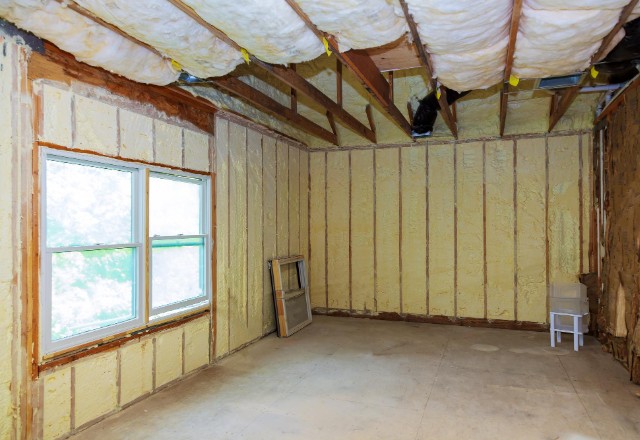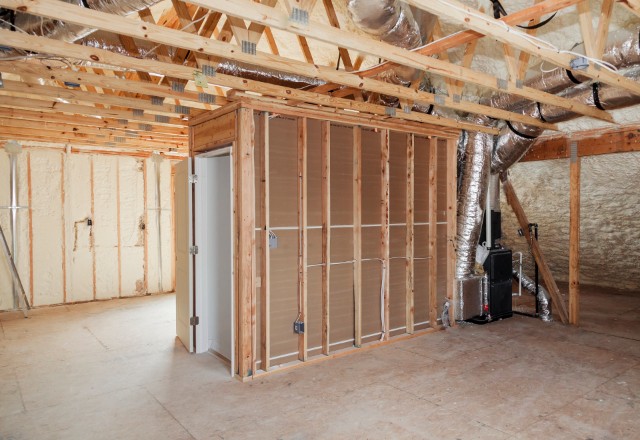Spray foam insulation is a popular insulation type made from a mixture of isocyanate and polyol resin that is sprayed onto various surfaces using specialized equipment. The mixture expands and fills in all available gaps and areas, creating a powerful air barrier that helps to efficiently block heat transfer. This type of insulation can be applied to all sorts of surfaces including roofs, walls, attics, and crawl spaces to provide an airtight seal that reduces energy costs and provides a high level of energy efficiency. In this article, we’ll explore some important aspects of spray foam attic insulation such as its lifespan, how to add or remove it, and its pros and cons.
We professionally install all types of insulation for walls, attics and roofs
Call us (509)201-4190 or send the form
Disclaimer: The information provided in this article is for general knowledge only. It does not take into account any individual’s specific circumstances, and should not be construed as professional advice or used as a substitute for such. For specific advice regarding your project, we recommend consulting with a qualified contractor. Advance Roofing LLC has been proudly serving the Spokane, WA area for many years with the highest standard of quality roofing solutions and are always happy to help.
Spray Foam Attic Insulation: Key Advantages
Spray foam attic insulation is an excellent solution for homeowners seeking to improve the energy efficiency of their homes. The process involves spraying a foam insulation material to the interior of the attic to create an airtight seal, which ultimately reduces heat transfer and lowers energy costs.
There are three primary types of spray foam attic insulation: open-cell, closed-cell, and hybrid sprays. Open-cell is less expensive but less dense, while closed-cell is more costly but denser and offers better thermal performance. Hybrid sprays combine the best features of both.
In addition to energy savings, spray foam attic insulation offers improved air quality and soundproofing abilities. By creating an airtight seal, it reduces the risk of moisture and mold growth, improving overall indoor air quality.
Types of Spray Foam Attic Insulation

Spray foam attic insulation is a popular and effective solution for homeowners looking to improve the energy efficiency of their homes. However, not all foam attic insulation is created equal. There are different types of foam insulation available, each with its own unique benefits and drawbacks.
Open-Cell Spray Foam
Open-cell spray foam insulation has become an increasingly popular choice for homeowners who are looking for a cost-effective and efficient way to insulate their attics. This type of insulation is made up of tiny cells that are not completely closed, allowing air and water vapor to pass through it. This characteristic makes it an excellent choice for attics, which require proper ventilation to prevent the buildup of moisture that can cause mold growth and damage to your home.
- Unlike closed-cell spray foam insulation, which has a higher R-value and is more expensive, open-cell foam insulation is much more versatile and easier to install. It can be sprayed on different surfaces, including walls, roofs, and attic floors, and can conform to any shape or size. It is also more effective in controlling air leaks, making it ideal for sealing gaps and cracks in your attic.
- Open-cell spray foam insulation is a great option for homeowners who want to save on energy costs while enjoying a comfortable indoor environment. Its air-sealing properties prevent heat loss during colder months and keep cool air in during warmer months, resulting in lower utility bills.
- Furthermore, it can also reduce noise levels by dampening sound vibrations within and outside your home.
While open-cell spray foam insulation is a highly effective attic insulation option, it is important to note that it should only be used in dry areas. If it is exposed to moisture, mold and mildew growth can occur, leading to structural damage. Thus, it is important to enlist the help of professional spray foam installers who can assess your home’s environment and determine if open-cell spray foam insulation is the right choice for your attic.
Closed-Cell Spray Foam Insulation
Closed-cell spray foam insulation is a type of insulation that has a much higher density than open-cell foam insulation. The density of closed-cell foam typically ranges from 1.5 to 2.0 pounds per cubic foot, making it more resistant to moisture and heat conductivity. The foam consists of tiny cells that are tightly packed, which creates a barrier that prevents air and water from penetrating the insulation.
One of the biggest advantages of closed-cell foam insulation is its high moisture resistance, which makes it ideal for attic insulation. If water penetrates the foam, it will not absorb into the insulation, but rather bead up and roll off. This prevents any mold, mildew, or structural damage from moisture buildup.
In addition, this insulation is highly effective in reducing heat transfer, which is an important factor in keeping your home energy-efficient.
Closed-cell foam also provides a noise barrier due to its density, although it is less effective at noise reduction than open-cell foam.
Closed-cell foam insulation also differs from open-cell foam in terms of weight, noise reduction, and cost. The density of closed-cell foam makes it much heavier than open-cell foam, which can make it more difficult to install. However, the added weight also provides a more durable and long-lasting insulation option.
While closed-cell foam insulation is an effective and durable insulation option, there are also some cons to using it. The high density of the foam means that it is the most expensive type of insulation, and it can be the most difficult to install. Additionally, closed-cell foam has the potential to shrink over time, which may impact its effectiveness in sealing gaps and air leaks in your attic.
Hybrid Sprays
If you’re considering foam insulation for your attic, you may want to explore the option of hybrid sprays. These types of insulation spray combine the benefits of both open-cell and closed-cell foam to provide optimal energy efficiency.
Hybrid sprays consist of a blend of chemicals that create a foam with a varied cell structure, allowing it to offer the best of both worlds. This unique composition gives hybrid sprays a higher R-value than open-cell foam and a better air-sealing capacity than closed-cell foam.
One of the primary benefits of hybrid sprays is their ability to balance the benefits of open-cell and closed-cell insulation. Open-cell foam is known for its high insulating value and cost-effectiveness, while closed-cell foam is valued for its durability, moisture resistance, and air-sealing properties.
Hybrid sprays have a lower vapor transmission rate compared to open cell foam, resulting in fewer moisture-related problems.
Additionally, this insulation type has a superior air-sealing ability than closed-cell foam, aiding in reducing energy loss and minimizing air leaks in the attic.
Because hybrid sprays have the benefits of both open-cell and closed cell insulation, they offer a more comprehensive solution for homeowners who want a balance between performance and cost effectiveness.
Hybrid sprays are a good choice for homeowners with homes that require a unique insulation solution based on their heating and cooling needs.
Advantages of Using Attic Spray Foam Insulation

Attic spray foam insulation is becoming increasingly popular among homeowners due to its numerous benefits. It offers superior thermal protection, air sealing, and noise reduction, making it an effective way to improve the energy efficiency and comfort of your home.
Improved Air Quality
Spray foam attic insulation can significantly improve the air quality in a home or office space. This type of insulation helps in reducing the amount of pollutants, dust and allergens that typically enter a living space through air leaks in the attic. The insulation creates an airtight seal that acts as a barrier, preventing these unwanted particles from entering the living space.
By reducing the amount of pollutants and allergens, spray foam insulation helps to create a healthier living environment. It can be especially beneficial for individuals who suffer from allergies or respiratory problems, as it can help alleviate symptoms.
In addition to improving air quality, there are also other advantages of an unvented attic space with spray foam insulation. Unlike traditional cellulose and fiber layers on the attic floor, foam creates an airtight and insulated space that helps to prevent heat loss. This can lead to increased energy efficiency and cost savings on heating and cooling bills.
However, it’s important to note that there are environmental considerations when choosing spray foam insulation. Spray foam is made from petrochemicals and undergoes a chemical reaction during installation that may result in the release of harmful chemicals if not properly mixed. It’s important to work with a professional installer and ensure that all necessary safety precautions are taken during installation.
Improved Energy Efficiency
Spray foam attic insulation is an excellent way to improve energy efficiency in any home or office space. Unlike traditional insulation materials, spray foam insulation creates an airtight seal that prevents air leaks, heat loss, and energy waste. By sealing all gaps, it can create a more effective barrier against air flow and heat transfer, reducing the amount of energy needed to keep the interior space at a comfortable temperature.
Heat loss through the roof is one of the main culprits of increased energy costs in a home or office space. When the roof is poorly insulated, warm air can escape through gaps or cracks, creating a draft and causing the heating system to work harder. The same applies to air conditioning in the summer months, where cool air can escape through the roof, forcing the cooling system to work harder and consume more energy. With foam attic insulation, the building’s roof is sealed, reducing heat loss, and cutting energy bills.
Spray foam insulation forms an airtight seal, preventing air movement through the insulation and creating a more efficient barrier against heat transfer. It also has excellent moisture reduction properties, reducing the risk of mold and mildew growth and preventing dampness.
Hybrid sprays are a newer innovation in the foam insulation space. These sprays mix traditional spray foam with other materials, such as recycled denim, to provide added insulation properties and increased sustainability. Hybrid sprays can offer benefits such as improved sound insulation and increased thermal resistance.
Increased Comfort Levels in Home or Office Space
When it comes to home or office space, comfort levels are crucial for enhancing productivity and overall well-being. Spray foam attic insulation can significantly improve comfort levels in your space by creating a more comfortable and consistent indoor environment. With this insulation type, you’ll experience increased comfort levels, leading to a better quality of life.
Spray foam insulation not only seals air leaks and gaps in your attic, but it also regulates the temperature in your space. During the summer months, it keeps your attic cool by blocking heat transfer from outside. In the winter months, it provides warmth within the room by retaining the heat generated by your heating system.
A properly insulated home delivers a range of benefits, such as reducing indoor drafts and ensuring consistent and even temperatures throughout the house. With spray foam attic insulation, you’ll enjoy fewer drafts and fewer instances of hot or cold spots in your house, resulting in a more comfortable living space for you and your family.
By improving your home’s comfort levels, you will experience a better quality of life, which, in turn, can significantly affect your overall well-being. You’ll find that you sleep better, are more productive, and have a more positive outlook on daily life when you are comfortable. With spray foam insulation, you can achieve a more efficient and comfortable home, leading to an overall improvement in the quality of your life.
Reduces Moisture and Mold Growth Risk
Spray foam attic insulation offers a range of benefits when it comes to keeping your home comfortable and energy-efficient. In addition to these benefits, foam insulation can help reduce moisture and mold growth risk in the attic.
By creating an airtight seal, spray foam insulation prevents air leaks and gaps that can allow moisture to seep into the attic. This is especially important in spaces with crawl spaces or unfinished attic floors, as these areas can be particularly prone to moisture and mold growth.
Proper airflow and temperature control work in conjunction with spray foam insulation to prevent moisture from building up in the attic. This is important because trapped moisture can lead to mold growth, which can compromise the air quality in your home and potentially cause health issues.
With spray foam insulation, you can enjoy improved air quality and reduced mold growth risk. This is because the insulation forms an airtight seal that keeps moisture out, while also ensuring that temperature and airflow are controlled in a way that prevents moisture from building up.
While spray foam insulation can greatly reduce moisture and mold growth risk, it’s important to note that reapplying foam insulation over old insulation may not be the best course of action. In some cases, it may be necessary to remove the old insulation to prevent potential moisture issues.
Improved Soundproofing Ability
Spray foam insulation is a great option for homeowners looking to improve soundproofing ability in a room. With its ability to create an airtight seal, spray foam insulation can help prevent outside noise from entering a room and minimize the amount of noise that transfers between floors.
The difference between open-cell and closed-cell spray foam can also effectively deaden sound compared to other insulation materials like mineral wool and blown-in fiberglass. Closed-cell spray foam has a higher density and can block more sound than open-cell spray foam, which is softer and more flexible but provides excellent sound attenuation.
For homeowners looking to reduce outside noise or minimize the amount of noise transferring between floors, the recommended insulation materials include spray foam insulation, mass-loaded vinyl, and acoustic foam.
When evaluating insulation materials for soundproofing, it is essential to consider the Sound Transmission Class (STC) rating of each material. The STC rating gauges the capacity of materials to decrease sounds, with higher numbers indicating more significant sound attenuation. Spray foam insulation usually has an STC rating of 37 or higher, making it a suitable option for enhancing soundproofing ability.
Cost Savings for Utility Bills and Heating/Cooling Systems Maintenance Costs

Spray foam attic insulation offers homeowners a wide range of cost savings benefits, particularly when it comes to utility bills and heating/cooling system maintenance costs. One of the primary ways in which spray foam insulation can help save on utility bills is through its ability to improve energy efficiency within the home.
By creating an airtight seal around the attic space, spray foam insulation reduces the amount of air leakage and drafts that occur within the home. This means that less hot or cool air escapes from the home, reducing the need for HVAC usage and ultimately leading to lower energy bills each month.
In addition to its energy efficiency benefits, spray foam insulation can also help reduce the need for ongoing maintenance and replacement costs for heating and cooling systems. Because the insulation helps regulate and maintain a consistent temperature within the home, heating and cooling systems don’t have to work as hard to keep the home comfortable. This reduces the wear and tear on these systems, leading to fewer repairs and replacements needed over time.
To maximize the cost savings benefits of spray foam insulation, it’s important to focus on proper installation and ongoing maintenance. This means hiring a professional installer to ensure that the insulation is applied correctly and effectively seals the attic space. It also means regularly checking for any signs of damage or deterioration to the insulation and repairing or replacing it as needed.
Installation Considerations for Attic Spray Foam Insulation

When it comes to installing attic spray foam insulation, there are several important considerations to keep in mind. Proper installation is key to maximizing the energy efficiency benefits of this type of insulation, as well as minimizing any potential issues related to moisture buildup, ventilation, and more. In this article, we’ll take a closer look at some of the key installation considerations you should keep in mind when installing attic spray foam insulation.
Professional Installation Services Recommended
When it comes to attic foam insulation, professional installation services are highly recommended. Installing spray foam insulation in an attic requires a specialized skill set, and the installation process can be quite complex. Attempting the installation on your own can lead to costly mistakes and compromised insulation efficiency. It is important to hire a professional who is experienced and knowledgeable in the proper installation of foam insulation.
One of the key benefits of hiring a professional installer for your attic spray foam insulation project is ensuring proper air sealing. Foam insulation creates a barrier that seals all air leaks and gaps, which is necessary to achieve maximum insulation efficiency.
Professional installers have the expertise to properly identify and seal all air leaks, preventing heat loss during the winter and air conditioning loss in the summer.
Another advantage of professional installation is avoiding costly mistakes. Improper installation can result in air leaks, improper insulation thickness, and even damage to your home. Professional installers are trained to avoid these mistakes and ensure that your attic is properly insulated without any damages.
When selecting a professional for your attic spray foam insulation project, it is important to consider their experience, knowledge, and licensing. Look for an installer who has completed similar projects and has a proven track record of success. Ask questions about their knowledge of foam insulation and if they are licensed to work in your area. A licensed professional can ensure that your installation meets local building codes and regulations.
Lifespan of Spray Foam Insulation
Spray foam attic insulation is known for its durability and longevity when proper installation and maintenance are carried out. The expected lifespan of spray foam attic insulation may vary and primarily depends on various factors, such as quality installation, environmental conditions, and maintenance measures taken.
On average, spray foam insulation in attics can last for up to 20 to 30 years before needing replacement. However, it’s essential to note that this lifespan may vary, and there’s no guarantee that the insulation will last that long, especially if it is poorly installed or poorly maintained.
Regular inspections and maintenance measures can help extend the lifespan of your spray foam attic insulation. It is recommended that you inspect your spray foam attic insulation regularly to ensure it remains intact and properly seals your home’s air leaks.
As spray foam insulation ages, it may show signs of wear and tear. For instance, it may start to shrink or crack, which can significantly affect its insulating capabilities. In case of any visible signs of wear and tear, you should consider reapplying the insulation to maintain maximum efficiency.
Conclusion
In conclusion, spray foam attic insulation is a popular option for homeowners looking to improve their home’s energy efficiency and comfort level.
When it comes to installing foam attic insulation, several considerations should be kept in mind, including the type of foam, the thickness required, and the cost of the installation.
With proper installation and maintenance, this insulation can last for up to 20 to 30 years, making it a worthwhile investment for any homeowner.



 509-201-4190
509-201-4190
